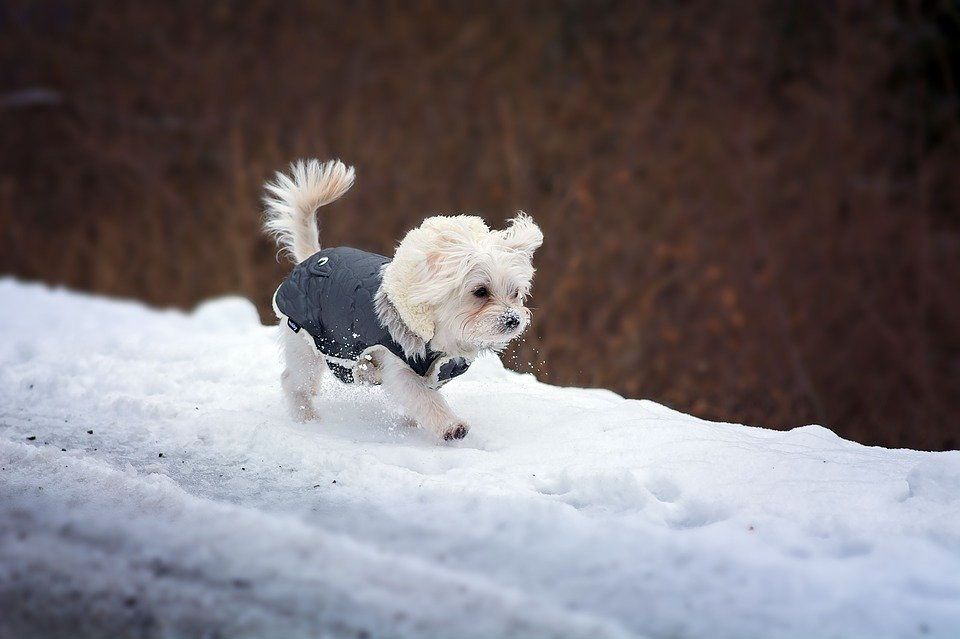 As the weather turns colder, we thought we’d give you a few top tips on keeping your dog safe, active and warm over the winter months.
As the weather turns colder, we thought we’d give you a few top tips on keeping your dog safe, active and warm over the winter months.
1. Acclimatise To Cold
Dogs get cold in snow and ice too. The best thing to do is introduce them to it gradually. Let them outside for shorter periods of time and keep walks slightly shorter. If they aren’t shivering, then they’re fine and can be allowed out for longer, but it’s always good to start shorter and work up.
2. Check Between Their Toes
Snow between your dogs toes can turn into ice balls and can be very painful for your dog, so always check them when they’ve been out in the snow. If you have a long haired dog then you may want to trim the fur between their toes a little to prevent the build up of ice.
Additionally, salt and grit can get lodged between their toes and can also cause skin irritation to other parts of their body, so wipe down their feet, legs and stomach after a walk.
3. Keep Them Warm & Dry
Allow your dog’s winter coat to grow. If you have a short haired dog or a puppy, then you may want to invest in a winter coat for them.
You should also make sure that you dry your dog off well when you get back from a walk and ensure they have a cosy bed to go back to that is away from draughts.
4. Keep Them On A Lead
When it snows heavily dogs can get extremely excited, so keep them on a lead in heavy snow so that they don’t get lost.
5. Keep Away From Antifreeze
Antifreeze is highly poisonous to dogs, but tastes sweet. Look out for any blue or green substances on driveways and if you have a spill, mop it up straight away. Keep the lid on any antifreeze bottles screwed on tightly and make sure you clean their paws when they come in from a walk, just in case they have picked some up from the road or pavements.
6. Stay Active Indoors
If the weather is bad and walks can’t be done or need to be shorter, there are plenty of indoor activities to help your dog get the exercise they need. You can use treats to play games around the house or play hide and seek with their toys. If they have plenty of toys to play with then there’s always something for them to do indoors.
7. Adjust Food As Required
If your dog is getting less exercise during the winter months then it’s a good idea to adjust their food accordingly. When it’s cold your dog can get a little more lazy in general, so it’s a good idea to reduce their calorie intake. It may also be useful to give them high quality, whole foods or a raw meat based diet to help give them a good coat for the winter.
8. Recall & Visibility
Some dogs have good recall. Others not so good. In the cold, foggy winter days your dog may not be as visible, so if they don’t have great recall it may be an idea to keep them on the lead. Additionally, make them even more visible using high visibility strips or LED lights attached to their collars and ensure your dog is microchipped and the contact details are all up to date.
9. Moisturise
The cold and dry weather can make your dog’s skin dry or flaky. You can use a skin and coat supplement to help avoid this and keep their coat healthy. Also, your dog may get dry or cracking paws, ears or tail. You can apply paw treatments or use coconut oil to help with this.
10. Don’t Leave Your Dog In The Car
Everyone knows that leaving your dog in the car in hot weather is really dangerous, but the same can be said for cold weather too! In winter, the temperature in a car can drop quickly, leaving them at risk. Always take them with you if you’re likely to be any length of time.
11. Frozen Water
As we would with children, keep dogs away from frozen lakes, ponds and rivers. Your dog may get very excited about a frozen stretch of water, but the ice may not be thick enough to take their weight and it’s impossible to know how secure the surface is. Keep them on a lead if you think your dog is likely to jump into frozen water and, if they should fall or jump in, don’t be tempted to go in after them. Try to encourage them back to you and call emergency services.
12. Keep Yourself Visible
Just like your dog isn’t as visible to you in ice, snow and fog, you aren’t as visible to them. Make sure you’re wearing brighter colours so they can pick you out more clearly from a distance.
